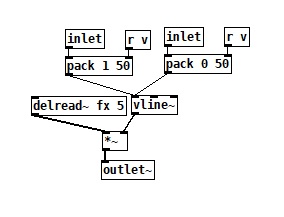To simulate Hammond’s vibrato scanner unit in Pure Data, I first had to find a way to replicate the delay line. Although there are many externals including all-pass and comb filters that would be suitable for this purpose, I had to keep in mind that BELA supports only Vanilla objects so I had to work with a limited library.

An obvious starting point was to use the [delwrite~] object, which allocates memory to a buffer and writes an audio signal into it. This signal is then read by the [delread~] object of the same name with a variable delay time, which can be defined in milliseconds. As it is possible to use more than one [delread~] object for the same buffer, I was able to set up multiple delay taps for the same signal, where each step is being delayed by 5 milliseconds relative to the previous one. Mixing these with the original signal results in amplification and cancellations at regular intervals, producing a comb filter in the end.
Next, I built a mechanism based on the scanner that could sample these delay taps. To do this, I first created a simple counter that increments by one with a specified velocity and then starts over when the given maximum value is reached. Its value is then passed to a select object, which sends a bang to the corresponding outlet when the value matches its argument. This results in a sequencer actually, which is ultimately what the scanner also is.

To connect the delay line to the sequencer, I placed a [vline~] object at the output of each tap. [Vline~] creates linear ramps whose levels and timing are determined by the messages you send. By creating a ramp-up and ramp-down message for each [vline~] object, I was able to toggle the volume of the taps on and off in a specific order so that each successive bang increases the volume of its assigned tap while turning down the previous one. To make sure that there is always a smooth transition between the taps, I made the duration of the ramps relative to the speed of the sequencer’s clock, achieving a perfect crossfade at any given rate.
To adjust the depth of the fades, I do multiplications on the ramp value that is sent to the [vline~] with a value between 1 and 5. The larger this number, the less accentuated the ramps are, and the smaller the depth is. This also means that the smaller the depth, the more the taps get mixed, which results in a chorus effect subsequently. Additionally, by mixing the dry signal with the scanner, a chorus-vibrato can be achieved, just as in the original Hammond design.